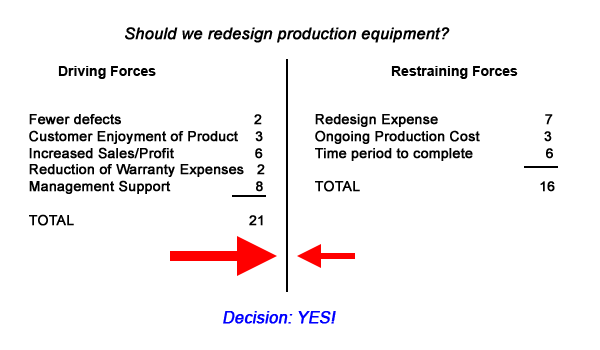
A force field analysis is a decision making tool which clarifies the advantages and disadvantages of making a decision. It is an important tool for project managers and executives, and basically anyone who needs to get a firm grasp of the underlying issues before making a big decision.
It’s pretty basic. In fact, it’s so simple you might wonder why it has a name.
If you are wondering whether to pursue a course of action within in your organization (or anywhere), then force field analysis is for you. It works like this:
- Identify all of the forces which that are working for the change. i.e. why you would want to do it. These are called the driving forces.
- Identify all of the forces against the change. i.e. why you would not want to do it. These are called the restraining forces.
- Give each a score. 1 – 10 works pretty good. Positive for driving forces, negative for restraining forces.
- If the score is positive, proceed with the change.
- Manipulate the score by managing, controlling, or mitigating each factor, if that is your intent.
Of course, each underlying factor has now been itemized which makes for ease of communication and debate among stakeholders. Force field analysis is a valuable decision making tool, even if it’s simple.
Example
In the following example, the positives outweigh the negatives, and the decision to undertake the re-design should be made:
Analysis
I actually did a Force Field Analysis without knowing it a few years ago, when I was deciding whether to quit my job and start my own company. Now I try to itemize and prioritize each factor (i.e. perform a Force Field Analysis) whenever there’s a big decision to make.
My experience is that many items tend to overlap so it’s important to differentiate between factors that are not mutually exclusive. For example, in the above example “reduction of warranty expense” could be considered as a sub-item of “increasing sales/profit” and thus too many points are awarded when you include both.
There isn’t really a good way around that. If you want to include warranty expenses in the analysis, you have to make a reduction out of the profit item, or realize the analysis is slightly skewed.
Once the brainstorming is done, each of the items can be analyzed and investigated to see if they can be managed, controlled, or mitigated. Here’s a quick checklist:
- Can the factor be modified?
- If so, how quickly, and what would the impact be on its score?
- Who are the stakeholders?
- Can a trade off be made to mitigate the factor?
- Can the factor be controlled using 3rd party methods?
- Can it be moved to another department (i.e. out of my decision)?
- Will the factor increase or decrease with time?
Origin
Force field analysis was developed by social psychologist Kurt Lewin in the 1940’s. The name originates from the concept that when the factors pushing for a change overpower the factors opposing it, the change will occur. To put it another way, when a change makes sense people will begin to push for the change, creating a “force field” for the change. When the force field pushing for the change overpowers the force field resisting the change, it will occur.
The force field analysis simply itemizes the force field on both sides and breaks it down into it constituent parts.
“May the force be with you”







